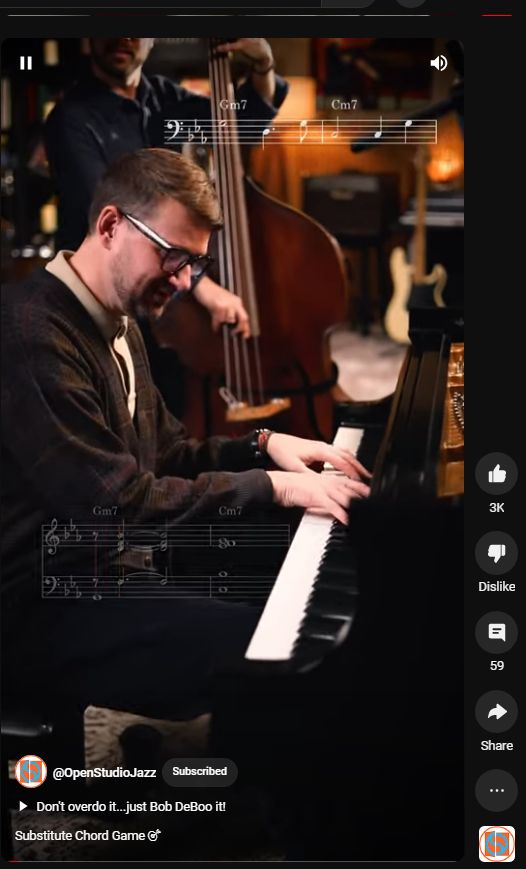Chord Sub Game
Category: Musical Performance
The Chord Substitution Game: Transforming Musical Performance On-the-Fly
Introduction
In the dynamic world of live musical performance, the ability to adapt and improvise is a crucial skill that sets exceptional musicians apart. One fascinating technique that exemplifies this adaptability is the “chord substitution game.” This game involves changing the harmonic structure of a piece of music on-the-fly by substituting one chord for another, thus creating new and unexpected musical textures. This blog post delves into the intricacies of the chord substitution game, exploring its mechanics, benefits, and the creativity it unleashes in musical performance.
Understanding Chord Substitution
Chord substitution is a technique where a musician replaces the original chords of a song with different chords that are harmonically related or create a new harmonic direction. These substitutions can be simple or complex, ranging from swapping a single chord to completely re-harmonizing a section of music. The goal is to enhance the harmonic richness of the performance, introduce new colors, and surprise the listener with unexpected turns.
The Mechanics of Chord Substitution
- Identifying Chord Families:
Every chord belongs to a family of chords that share similar harmonic functions. For example, in the key of C major, the primary chords (I, IV, and V) can often be substituted with their relative minors (vi, ii, and iii, respectively). Understanding these relationships is the first step in mastering chord substitution. - Functional Harmony:
Chords have specific functions within a key—tonic (I), subdominant (IV), and dominant (V). Substitutions often maintain the functional role of the original chord. For instance, a dominant chord (G7 in C major) can be substituted with a diminished chord (Bdim) or a secondary dominant (D7). - Using Passing Chords:
Passing chords are transitional chords inserted between the primary chords to create a smoother or more interesting progression. For example, instead of moving directly from C to Am, a musician might insert an E7 as a passing chord. - Altered Chords and Extensions:
Adding extensions (e.g., 7ths, 9ths, 13ths) or altering notes within the chord (e.g., sharping or flatting the 5th or 9th) can provide a fresh take on a familiar progression. For instance, replacing a G major chord with a G7#9 creates a more complex and jazzy sound.
The Process of On-the-Fly Substitution
- Preparation and Practice:
Successful on-the-fly chord substitution requires a deep understanding of music theory and extensive practice. Musicians often rehearse common progressions and their possible substitutions to build a repertoire of options. - Listening and Communication:
In a live setting, musicians need to be highly attuned to each other. Non-verbal cues and a shared musical intuition help coordinate the substitutions without disrupting the flow of the performance. - Spontaneity and Creativity:
The beauty of the chord substitution game lies in its spontaneity. Musicians draw on their knowledge and intuition to make split-second decisions, creating a unique performance every time. This creativity keeps the music vibrant and engaging for both the performers and the audience.
Benefits of Chord Substitution
- Enhanced Harmonic Complexity:
Chord substitutions add layers of harmonic richness and complexity to the music, making it more interesting and emotionally engaging. - Improvisational Flair:
This technique showcases a musician’s improvisational skills, allowing them to demonstrate their creativity and deep understanding of harmony. - Keeping Performances Fresh:
Regularly incorporating chord substitutions ensures that each performance is unique, preventing the music from becoming stale or predictable. - Audience Engagement:
Listeners are often captivated by the unexpected twists and turns that chord substitutions introduce, making the performance more memorable and impactful.
Examples in Popular Music
- Jazz Standards:
Jazz musicians frequently use chord substitutions to reinterpret standard tunes, adding a personal touch and exploring new harmonic territories. - Pop and Rock Music:
In genres like pop and rock, chord substitutions can add sophistication and depth to otherwise straightforward progressions. For example, The Beatles’ use of unexpected chords in songs like “Something” and “In My Life” adds emotional complexity to their music.
Conclusion
The chord substitution game is a powerful tool in the arsenal of skilled musicians, transforming simple progressions into intricate tapestries of sound. By mastering this technique, musicians can elevate their performances, continually surprise their audiences, and keep the art of live music vibrant and evolving. Whether in a jazz club, a rock concert, or a solo performance, chord substitution brings an element of unpredictability and excitement that is at the heart of musical creativity.
